by Sean Yates for the
Large Format Page.
with photographs by Sheldon Hambrick.
This camera series was made from the early 1960’s to around 1984. There are at least 4 variations and two brand names under which it was marketed - Orbit and Calumet. I have never seen any sales literature that lists this design as anything other than the C-1, but if anyone has an old catalog or factory literature listing it as a C-2 or C-3, I would gladly pay for a mailed photocopy or a fax
The design has its origins in the Ansco Commercial flatbed view camera — the Calumet is essentially a metal version of this proven design. It has extensive movements and bellows draw and is very durable and rigid. On the down side, it is bulky, heavy, and does not handle lenses shorter than a 10" very well. Also, it could never be considered beautiful in the way of a Deardorff or Ansco. Used by Cole and Brett Weston, and Christopher Burkett, it can still be found in studios throughout the United States. It was never an expensive camera and can be a very good deal. In fact, aside from the weight, it may well be the best "starter" camera in this format.
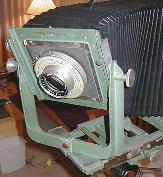
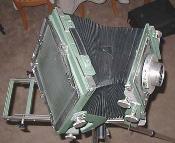
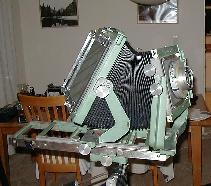
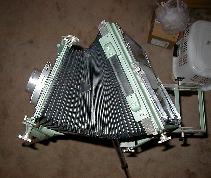
Front Rise & Fall - "geared" 5 inch total
Front Swing - on axis - unlimited
Front Tilt - on axis - unlimited
Front Shift 4-inch total
Rear Swing - on axis - 30º
Rear Tilt - on axis - 30º
Rear Shift 4" total.
Bellows Draw - 34" to perhaps 4"
Folded up the camera is around 18" X 14" X 10"

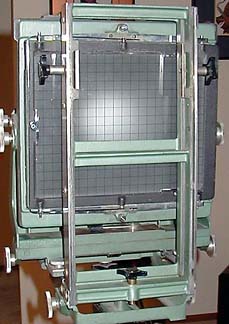
Like the Ansco, the Calumet rail folds flat against the ground glass for carrying, also granting a modicum of protection for the ground glass. Yes, despite the weight and bulk, this camera was promoted as portable. The rail folds down for use and a bolt secures it in place. The focus track slides within the rail, again, like the Ansco design, allowing a healthy bellows draw while keeping the overall size down. This also eliminates the need for a detachable extension rail, which the Kodak and Burke and James have, but which always seems to be missing on used specimens. The tripod block clamps to the rail and the camera can be slid back and forth within it, facilitating balancing the cameras' not inconsiderable bulk at long extensions. The tripod block is tapped for 1/4 X 20 and 3/8 X 16 tripod bolts. The camera focuses on the rear standard only.
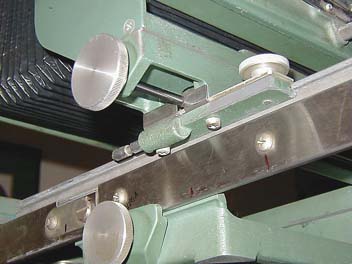
The camera was originally made with magnesium castings — giving it a weight of 14 lb. When a City of Chicago Fire Marshal inspected the facility where the camera was made, he was horrified to see piles of very flammable magnesium shavings lying about. This necessitated a change to aluminum and a resultant increase in weight, from a manageable (albeit hefty) 14 lb to the truly challenging for a "field" camera 18 lb. In addition to the castings, it has chrome steel and stainless steel parts. The change in materials occurred sometime around 1970 — the color didn’t change until later. So while all Black Beasts are aluminum, not all Green Monsters are magnesium. The only way to tell is to have a bathroom scale with you when you go to the camera store.
The main drawbacks to the design are its weight and bulk. Also, because of the length of the extension rail using lenses shorter than 10" can be difficult to impossible. It’s not that the camera can’t handle them - it can and well. But the camera only focuses on the rear and the rail sticks out backwards meaning to use short lenses you have to have a neck like those ladies with all the big gold bands in National Geographic Magazine.
Additionally, the bolt & screw that hold the front standard in place at the bottom, at the swing/shift movement is a bit week and prone to wear. Additionally, some of the knobs are made of plastic. A sort of Maltese cross design, not unlike the knobs on the Lotus cameras from Austria, the corners almost always seem to break off in transport — unless you have the camera in a case. Cole Weston maintains one of the main reasons he gave up 8 X 10 was due to the airlines manhandling his camera. While I would not like to shake hands with the man that could damage a C-1, I can see his point.
For some reason, the bail on the 4 X 5 camera and reduction back is well made — with a small wheel at the end of the bail arm that bears against the springs. On the 8 X 10 the designers seem to have decided to save cost, as the wheels are omitted, making the bail a rather crude affair that can scrape the springs and make a sound like fingernails drug across a chalkboard.
The variations of this camera I am aware of are the early version used by among others Yousuf Karsh, the familiar green and black versions, and an interesting short lens model sold by Orbit. This version gave up some movements front and rear, but added front focus, making short lens use easier. I have not seen many of them, in fact, the first one I saw looked rather "homegrown".
I called Calumet and talked to Jose in the parts department as John Hicks suggested. Calumet does have some parts available for the camera. They may be second hand, or NOS and some parts they lack entirely, but they do carry some parts. At one point Paul Mayberry of Clayton Classic Camera in Missouri had a parts listing and blueprint that he would fax upon request.
Case,
4 X 5 revolving reduction back with bail opening
5 X 7 reversible reduction back
Compendium Shade
Recessed reducing lens board
Wire focusing cloth support
